U.S. Energy Policy Comparison: A Detailed Look at Harris vs. Trump’s Approaches to Climate and Energy
A U.S. Energy Policy Comparison reveals key differences between two administrations. A Harris administration would likely expand clean energy initiatives to achieve net-zero emissions and support renewable energy sectors. In contrast, a Trump administration would likely roll back current climate policies, prioritize hydrocarbons, and reduce the influence of the IRA. Below is a comparison of each administration’s potential approach to key policy areas.
1. Methane Emissions and Regulation: A Key Area in U.S. Energy Policy Comparison
 Figure 1. U.S. Energy Policy Comparison of Methane Emissions and Regulations under Different Administrations
Figure 1. U.S. Energy Policy Comparison of Methane Emissions and Regulations under Different Administrations
Harris supports stricter regulations to reduce methane emissions in the oil and gas sectors. This aligns with her net-zero ambitions but would increase compliance costs for companies.
Trump, on the other hand, focuses on lowering costs by rolling back methane regulations. Thus, this contrast illustrates differing priorities—Harris focuses on environmental goals, while Trump emphasizes industry cost savings. This is key point in the U.S. Energy Policy Comparison.
2. Oil and Gas Industry and Renewable Energy Support: A Critical Comparison of U.S. Energy Policies

While Harris would prioritize renewable energy growth through continued IRA tax incentives, Trump would focus on reinforcing traditional energy sources like oil, gas, and coal. Consequently, this difference in focus results in Harris promoting job creation within renewable energy sectors, supporting economic resilience through clean energy investment. In contrast, Trump’s approach aims to sustain fossil fuel jobs, especially in regions where traditional energy industries dominate. This is a critical area in any U.S. Energy Policy Comparison.
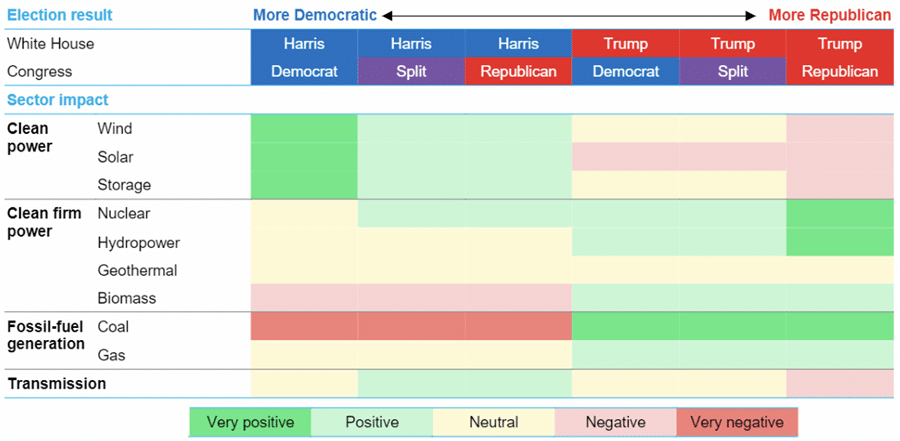
The U.S. power sector is accelerating its shift to renewables and energy storage, driven by cost reductions and state policies. Federal policy remains crucial, impacting how quickly hydrocarbons are phased out. Despite potential Republican opposition, the Inflation Reduction Act (IRA) is likely too economically valuable to be entirely repealed, with benefits that even a re-elected Trump might only alter rather than eliminate.
Election outcomes will shape the prospects for different energy sectors. Under a Harris administration with Democratic backing, clean power sectors like wind, solar, and storage would see substantial growth. Conversely, a Trump administration, especially with a Republican Congress, would favor hydrocarbons, giving coal and gas a strong market presence.
Clean firm power sources like nuclear and hydropower have bipartisan support, indicating steady opportunities regardless of administration. However, permitting complexities and regulatory challenges still need to be improved, especially for emerging technologies like geothermal and biomass. Transmission infrastructure sees positive outlooks, particularly under Harris, to support renewables; under Trump, the focus may shift to maintaining grid reliability without prioritizing clean integration.
3. Border Carbon Adjustment Mechanism (BCAM): Impact on U.S. Energy Trade and Emissions Goals
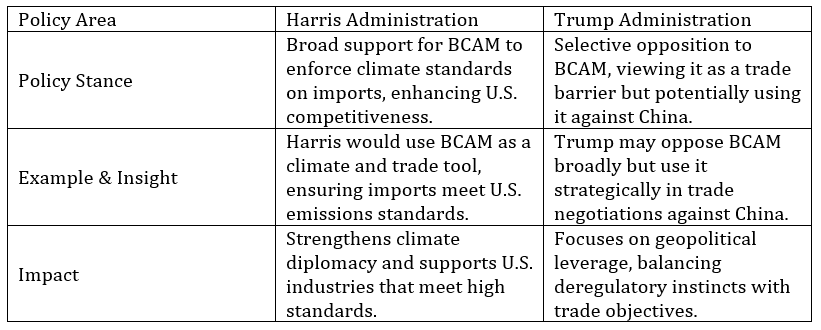
Harris’s support for BCAM reflects a commitment to climate compliance, enforcing environmental standards on imported goods to align with U.S. emission goals.
By contrast, Trump would likely view BCAM as an unnecessary trade barrier but may consider its strategic use to counter China’s influence in global trade. This difference highlights Harris’s focus on integrating environmental standards into trade policy, while Trump’s approach selectively applies BCAM as a tool for economic leverage.
4. Economic Impact of Clean Energy Tax Credits on the Red States: How U.S. Policies Are Shaping Economic Growth
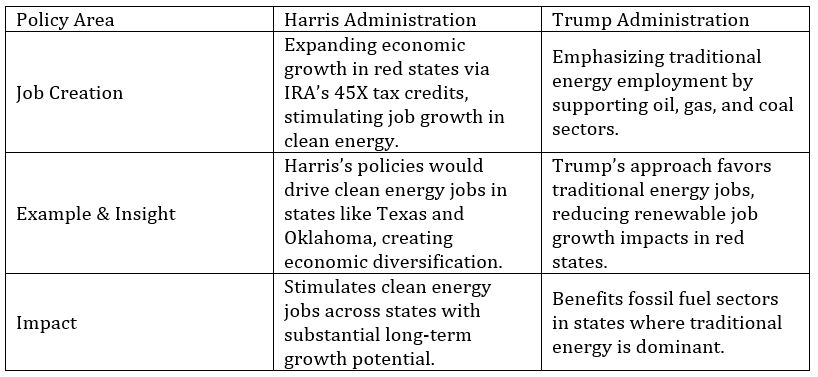
The 45X tax credits have brought significant economic benefits to red states, fostering job creation and investment in clean energy projects. This can be seen in establishing new manufacturing facilities and developing renewable energy infrastructure, which have provided substantial employment opportunities and economic growth in these regions.
States like Texas and Oklahoma, which traditionally rely on the oil and gas industry, have seen a surge in clean energy jobs due to the incentives provided by the 45X tax credits. Moreover, these credits have facilitated the establishment of new manufacturing plants for wind turbines and solar panels, leading to thousands of new jobs in these areas.
Harris would expand clean energy job opportunities in red states, leveraging 45X tax credits to encourage investment in renewable sectors like wind and solar. This strategy could diversify local economies that traditionally rely on hydrocarbons.
The first Trump administration’s stance on climate change and environmental regulations was skeptical. In addition, it often viewed them as burdensome to economic growth and energy independence. Trump’s administration would prioritize maintaining oil and gas jobs and reinforcing traditional energy employment.
5. Inflation Reduction Act (IRA) Policy Scope and Implementation: Key Policy Differences in U.S. Energy Legislation
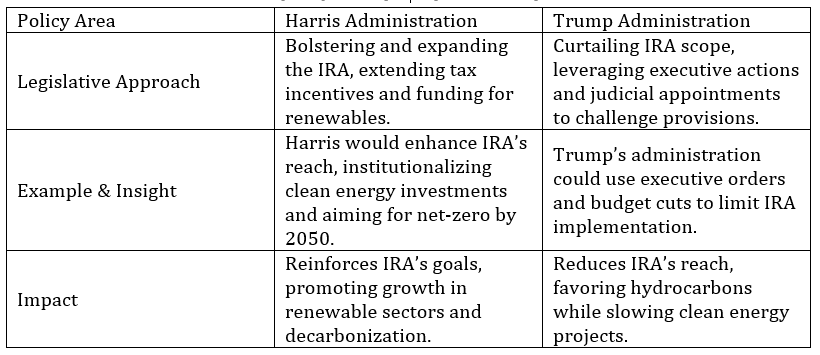
Harris’s approach would solidify and expand the IRA’s impact, institutionalizing clean energy investment with long-term funding and incentives to achieve net-zero by 2050.
Conversely, Trump would seek to limit the IRA’s scope, possibly challenging specific provisions through executive actions or judicial appointments. Changes in the composition of the judiciary can lead to rulings that undermine federal initiatives promoting clean energy. The Trump administration has previously appointed judges who favor deregulation and limited government intervention. Thus continuing this trend could result in court decisions that challenge the legality of various provisions within the IRA, potentially nullifying key aspects of the Act.
Summary of Approaches: Contrasting U.S. Approaches to Energy Policy
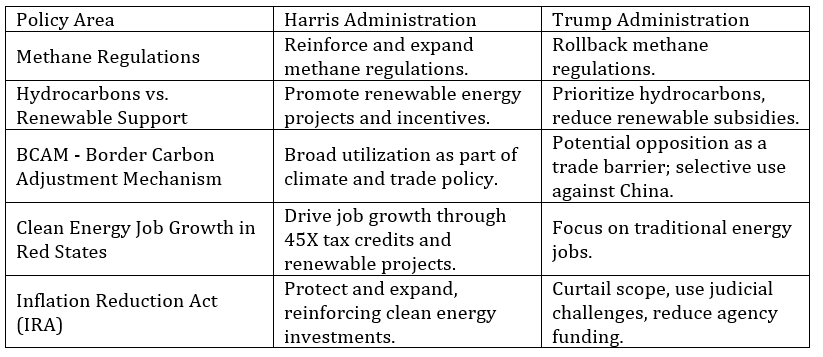
Harris’s approach reinforces the IRA’s role in supporting renewable energy, stringent emissions regulations, and climate-aligned trade policies.
Trump’s policies focus on deregulation, reducing renewable incentives, and bolstering traditional energy sources. Each approach presents a distinct vision for the U.S. energy future, with Harris championing sustainable development and Trump advocating for traditional energy reliability and independence.
How do different administrations shape the future of clean energy? Let’s explore their contrasting approaches and impacts through a detailed U.S. Energy Policy Comparison.
Experience In-Depth, Real-Time Analysis
For just $200/year (not $200/hour). Stop wasting time with alternatives:
- Consultancies take weeks and cost thousands.
- ChatGPT and Perplexity lack depth.
- Googling wastes hours with scattered results.
Enki delivers fresh, evidence-based insights covering your market, your customers, and your competitors.
Trusted by Fortune 500 teams. Market-specific intelligence.
Explore Your Market →One-week free trial. Cancel anytime.
Related Articles
If you found this article helpful, you might also enjoy these related articles that dive deeper into similar topics and provide further insights.
- E-Methanol Market Analysis: Growth, Confidence, and Market Reality(2023-2025)
- Climeworks 2025: DAC Market Analysis & Future Outlook
- Carbon Engineering & DAC Market Trends 2025: Analysis
- Battery Storage Market Analysis: Growth, Confidence, and Market Reality(2023-2025)
- IMO Decarbonization & Net Zero 2025: Policy Collapse
Erhan Eren
Ready to uncover market signals like these in your own clean tech niche?
Let Enki Research Assistant do the heavy lifting.
Whether you’re tracking hydrogen, fuel cells, CCUS, or next-gen batteries—Enki delivers tailored insights from global project data, fast.
Email erhan@enkiai.com for your one-week trial.

